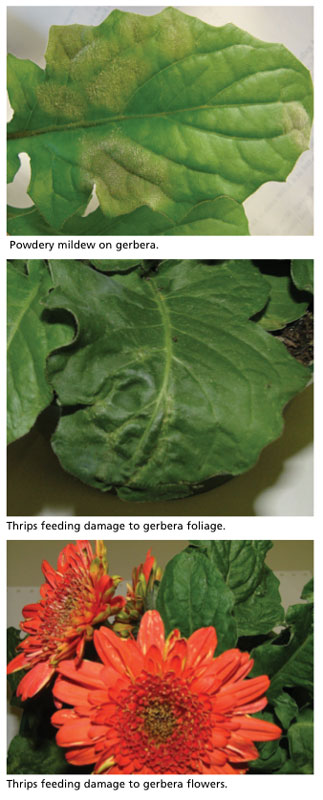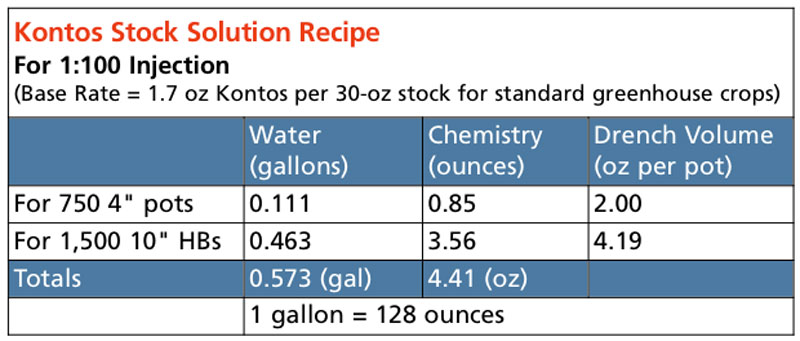11/1/2017
Secrets to Growing Gorgeous Gerbera
Tami Van Gaal

Consumers love daisies! And when it comes to daisies, nothing grabs consumer attention like a well-grown gerbera. Big, bold flowers drive sales at the grocery store floral counter and in the garden center.
This nearly perfect retail opportunity can also present growers with a few challenges. Fortunately, we’ve got solutions to most common gerbera production problems. Implement a few changes, avoid a few pitfalls and produce a spectacular crop.
Challenge #1: Thrips control
Thrips are problematic on many crops and have a stealthy ability to ruin a gerbera crop almost before growers know a problem exists. Thrips are drawn to the developing flowers very early, leaving highly visible streaking, necrosis and distortion when the flowers open. This same rasping feeding pattern also damages young leaves, resulting in highly visible feeding scars and distorted foliage. With only a handful of flowers open at sale, you can’t really afford to lose even a single flower to thrips damage. An iron-clad thrips control program is warranted.
Growers can use BCAs or chemistry to control thrips. If using BCAs, begin treatment with an inundative, bulk release of Amblyseius cucumeris at transplant to stop any larvae that may have come in with the young plants. From here, determine your strategy for treatment for the rest of the crop cycle based on whether or not a bridge of contact exists between the plants. If pots are touching or share a bridge of contact, turn to sachets. Use one Amblyline stick per shuttle tray. Replace sachets every four to five weeks for continued production. If pots don't share a bridge of contact, continue with weekly releases of A. cucumeris.
A. cucumeris will control only the larval stage, so partner the mites with control of additional life stages for full control. The next easiest life stage to target is the pre-pupal/pupal stage, which is most often found on the media. Control using drench applications of the beneficial nematode Steinernema feltiae (available as Nemasys, NemaShield, Exhibitline and Sentry). Make applications every two to three weeks, depending on pest pressure.
Thrips can also be controlled with chemistry. We regularly recommend a Kontos drench for superior thrips control (see the sidebar for Kontos application tips). The beauty of using Kontos is that control also extends to aphids, spider mites and whiteflies, essentially covering all the bases for gerbera. Count back seven weeks from your sell date to time your Kontos application. This allows for several weeks for uptake and a solid five weeks of control. Prior to the Kontos application, plan one of the following spray strategies:
Spray Rotation, Option A:
- Starting two weeks before the drench, make two applications of Pylon (MOA 13) or an Avid/Azatin tank mix (MOA 6 and UN); apply twice at a five-day interval. Follow with an Overture spray at the time of drench (MOA UN, two weeks of control).
Spray Rotation, Option B:
- Two weeks before the drench, apply a BotaniGard/Azatin O tank mix series (MOA UN). Apply the tank mix followed by BotaniGard alone four days later, then another application of the tank mix four days after that. Mycotrol ESO may be subbed for the BotaniGard, and AzaGuard or Molt-X may be subbed for the Azatin O.
- Follow with an Overture spray at the time of drench (MOA UN, two weeks of control).
Mainspring presents another option for long-term thrips control from a drench. Mainspring moves very quickly into the crop and provides long-lasting control for at least four weeks. Keep in mind that thrips must be controlled prior to drenching Mainspring. Scout carefully and employ one of the spray strategies outlined above.
For suggestions for soft chemistry options for thrips control and control of broad mites, see the sidebar.
Challenge #2: Powdery mildew
While not sensitive to a wide range of foliar diseases, gerbera are particularly sensitive to powdery mildew. In fact, gerbera will be one of the first crops to show powdery mildew under the conducive conditions of dry foliage and high humidity.
The best way to avoid disease development is to manage the greenhouse environment to reduce humidity by venting and/or heating. However, the weather doesn’t always cooperate and preventative treatments are warranted when conditions are likely to support disease.
One of the best options for prevention of powdery mildew just happens to be an OMRI-listed, soft chemistry: Regalia PTO. Sprayed ahead of the onset of disease, Regalia PTO will effectively prevent powdery mildew on gerbera. Cease, Mural, Pageant Intrinsic, Protect DF or Triathlon BA are also good options for prevention. If disease does develop, turn to Affirm, Eagle, Milstop, Palladium or Strike Plus.
Challenge #3: Nutrient deficiencies
Gerbera roots have a high demand for oxygen and the plants greatly resent saturated conditions caused by overwatering. Saturated conditions also limit uptake of boron and calcium. Resulting deficiency symptoms show as distortion of the young tissue—look for spoon-shaped leaves and narrow petioles.
Deficiencies can be minimized with application of boron and inclusion of calcium-based feeds in the fertilizer rotation. However, the best way to avoid these deficiencies is by encouraging strong transpiration with adequate plant spacing, good airflow from HAF fans, use of a well-drained media and careful watering practices.
Interveinal chlorosis of the older leaves indicates a magnesium deficiency. Magnesium deficiencies are quickly reversed with an application of Epsom salts at 8 oz./100 gal.
Challenge #4: Poor flower development
A gerbera crop without flowers isn’t likely to result in good sell-through at retail. The most common causes of low flower count in gerbera relate to a lack of light reaching the crown. Be sure to avoid deep planting of the liners, as burying the growing point will nearly guarantee reduced flowering and reduce crop uniformity. Even when planted to the proper depth, crowding will reduce flower count through shading. This effect can occur at any point in the production cycle, including the plug or liner stage. Avoid shading by planting young plants on time and space crops as soon as neighboring leaves touch.
A little attention to avoiding the most common production problems for gerbera will result in a smoother season and beautiful plants with strong impulse appeal. The end result is well worth the extra attention during production.
Not all products are registered for use in all states. Some pesticides are restricted-use in some states or regions. It’s the responsibility of the applicator to read and follow all label directions, remembering that labels may change. Other products may also be safe and effective.
More Tips to Manage Pests in Gerbera
Thrips control with soft chemistry
Thrips can be controlled with use of soft chemistries when the program relies on a few key strategies:
1. Scouting must be focused and proactive in nature. Change sticky cards weekly and record pest counts. Perform beat tests and identify specific crops and locations that should be monitored more closely as early indicators of thrips presence.
2. Begin spray applications at first sign of thrips presence.
3. Focus on effective products and use them appropriately.
Several bioinsecticides have shown good efficacy against thrips. Grandevo PTO is an OMRI-listed bacterial product that’s slow to act, but effective when applied weekly. Make at least three applications at seven-day intervals. Preferal uses a naturally occurring fungus as its active ingredient. This OMRI-listed product should also be applied at first sign of thrips either as a spray or a drench.
Preferal is best applied using a TeeJet nozzle and when relative humidity will be at 80% or higher for eight to 10 hours. Met 52 is also effective against thrips when used as a spray or a drench.
The BotaniGard/Azatin O tank mix mentioned in the main article is also considered to be a soft chemistry. For a fully OMRI-listed option, sub Mycotrol ESO for the BotaniGard. Remember the spray protocol:
- Day 1: BotaniGard/Azatin O tank mix
- Three to five days later: BotaniGard alone
- Three to five days later: BotaniGard/Azatin O tank mix
- If desired, sub Mycotrol ESO for the BotaniGard and AzaGuard or Molt-X for the Azatin O
Control of broad mites
Like thrips, broad mites can cause devastating damage to gerbera crops. The microscopic mites feed on the young growing tips, injecting a toxin, which causes hard, stunted growth with darkened leaves. Broad mites can also cause flower damage.
Translaminar systemic miticides are preferred because broad mites are reclusive, making it difficult to get good contact with spray applications. Choose from one of the following miticides, making two applications at a seven-day interval: Avid, Judo, Pylon or Sirocco. Drenches of Kontos are also effective, but take three weeks to take full effect, during which broad mite damage will continue to develop. For this reason, Kontos should only be applied preventatively for broad mites.
Kontos use tips
 Kontos is a great product, though the product label can be confusing to many growers. The first thing to recognize is that proper application requires delivery of a specific amount of Kontos in a specific application volume. An easy rule of thumb is to apply 0.5 oz. of Kontos drench solution per inch of pot.
Kontos is a great product, though the product label can be confusing to many growers. The first thing to recognize is that proper application requires delivery of a specific amount of Kontos in a specific application volume. An easy rule of thumb is to apply 0.5 oz. of Kontos drench solution per inch of pot.
The potentially confusing part is that the label doesn’t directly reference the actual rate. Instead, it describes how many pots should be treated with a specific amount of chemistry. When the application volume is considered, this translates into 1.7 oz. of Kontos in a 30-oz. stock tank injected at 1:100 for 1,000 6-in. pots. Confused about how to ramp this up for larger numbers of differing pot sizes? You’re not alone! Contact your supplier for help with a Kontos recipe that’s right for your program.
Important note: Due to risk of severe phytoxicity, DO NOT apply Kontos to geraniums, verbena, dracaena, cordyline, ferns, orchids, croton, some palms or schefflera. Review the label for phyto cautionary statements.
The information provided above does not replace the need to read and follow the directions on the entirety of the product label. This information doesn’t supersede any applicable law, regulation or standard. While every effort has been made to ensure the accuracy of the information, human error is possible and labels do change without notice. GT